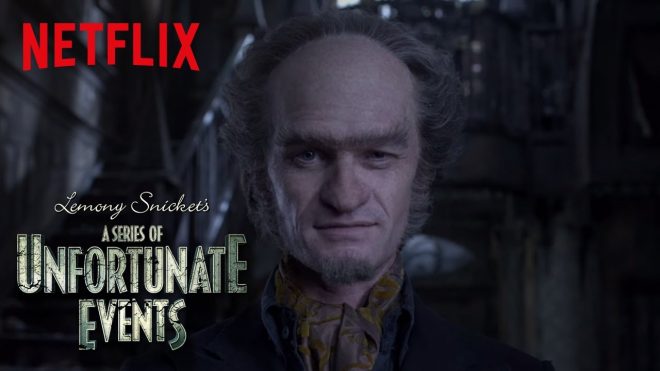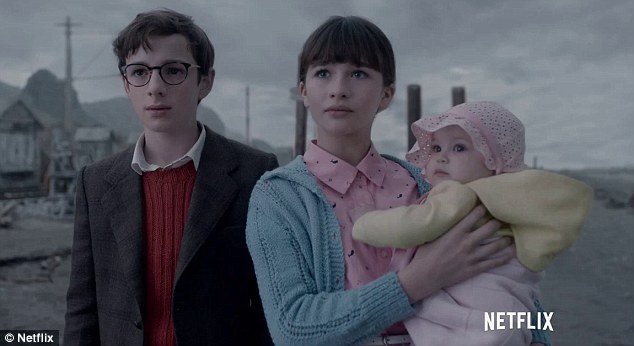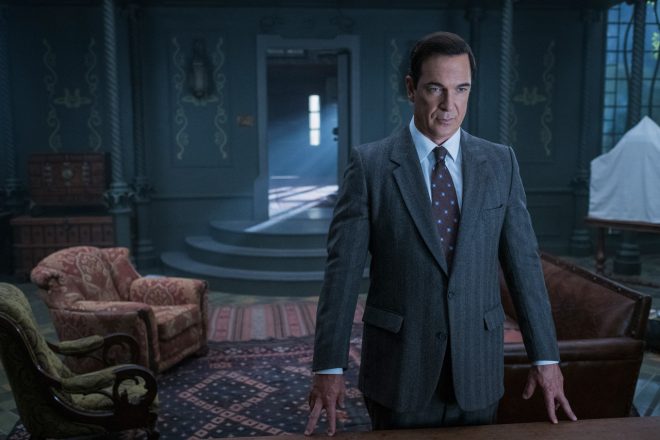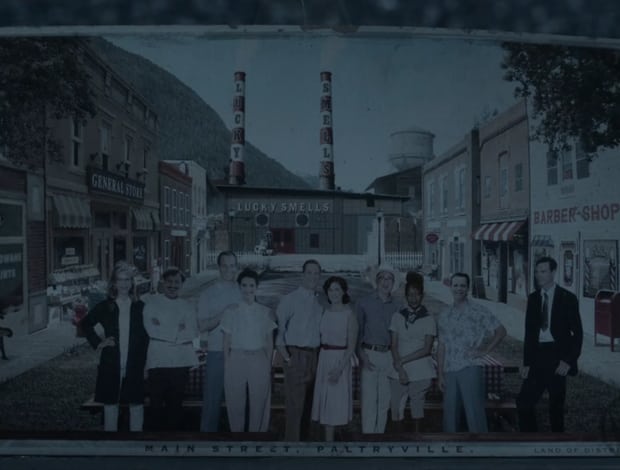The Series of Unfortunate Events, told by narrator Lemony Snickets, is a series of 13 novels that first released in 1999. On January 13, 2017, Netflix released the A Series of Unfortunate Events as a Netflix Original. Although there are over a dozen novels, the first season of the Netflix adaptation covers the first 4 books: Bad Beginnings, The Reptile Room, Wide Window, and Miserable Mill.
[iframe id=”https://www.youtube.com/embed/MGhd6dpRy-w”]
I still vividly remember searching for and reading these books in my school library when I was in 5th grade. Although I remember seeing the movie version of this series, which covered the first three books, the movie franchise never continued. This left fans in the dust, only getting a taste of A Series of Unfortunate Events and on-screen vision, until January of 2017.
The scene opens with the three Baudelaire children, each of their characteristic qualities which are explained to the audience through the aid of narrator Lemony Snickets. The infamous villian, Count Olaf, soon enters the picture as he is the first stop on the Baudelaire guardian tour. It is immediately evident that Count Olaf’s character has a narcissistic personality and selfish actions that follow in suite. However, Count Olaf’s story is more complex than his relentless ploy to get his hands on the Baudelaire fortunate. A story, that by the end of the first season, the audience begins to realize a relationship between all of the characters who have appeared throughout the series. From Count Olaf to Montgomery Montgomery to Aunt Josephine, they are all connected. And there is more that lies deep under the surface.

In relation to the novels, Netflix did a spectacular job of bringing this world to life. The visual aspects, such as the characters, the costume design and the set design, all are in perfect coordination with the books. But the effect the appearance has on the audience also, in turn, greatly effects the tone of the story. For example, playing with dark vs. light in the houses that represent joy and light for the Baudelaires; such as Justice Strauss’ house and Montgomery Montgomery’s home. While Count Olaf’s residence and Aunt Josephine’s eerie home are very dark, dull and lifeless. This represents how viewers picture these characters that serve as the host(s) of the house.
Lemony Snickets, the narrator in A Series of Unfortunate Events, is front and center in many of the scenes. He explains and foreshadows what is to come for the Baudelaire children, as a narrator typically does in a story. But it is unusual to see the narrator so often and up-close in the world of television and movies.
Incorporating the narrator into the on-screen adaptation of A Series of Unfortunate Events is essential. Not only does the narrator’s presence maintain the original story and how the audience received character and plot information; but the very idea of Lemony Snickets was also created as a fantastic figment by the author. We see the author’s internal thoughts coming alive from the book to its on-screen translation. Through the aid of Lemony Snickets, the audience can almost see the author’s presence (Bad Beginnings part 1).
One of the most notable qualities of A Series of Unfortunate Events is the story’s use of irony. The dark and twisted irony is a literary rarity not typically found among children’s books.

In Reptile Room part 1, Lemony Snickets defines and explains the meaning of dramatic irony. As adults, we know what this is and can pick up on it. But as children, the explanation of this word and its context in a children’s book is important to reinforce. This is one facet that depicts how the creators refused to change the nature of the story and how it is told, even if the audience is older. The essence of A Series of Unfortunate Events and how the creator portray the on-screen story remains true to the book.
Despite the awful or “unfortunate” series of events that unfolds, a strange sense of humor persists in the face of these hapless occurrences (Bad Beginnings part 1).
The use of irony in the series becomes even more blatant, if that’s possible, in Wide Window. For instance, the town of Paltryville’s name is originally titled as a misnomer (paltry meaning small or meager). The town was vivid and lively, but eventually became paltry due to environmental factors.
Another great example of irony in this series is Aunt Josephine. She seemingly has a phobia of everything under the sun. She believes everything poses a threat and that she, and those around her, are in constant danger. Yet, Aunt Josephine’s character chooses to live in a house hanging at the edge of a 300 foot drop, with a lake below that contains lachrymose leeches. However, ironically, Aunt Josephine’s fear of “real estate” super-cedes her fear of living in the dangerously structured and located house. Her irrational fear trumps what should be a rational fear. Two concepts, rational and irrational fears, which are defined by Lemony Snickets.
A Series of Unfortunate Events is also memorable for using great examples of literature. This strategy not only teaches children of these praiseworthy authors and novels. But Lemony Snickets also uses these books and/or figures to help get his point across and to create understanding in a humorous manner.
For instance, he describes the expression “out of the woods” in Miserable Mill part 1. Lemony Snickets depicts the saying as almost away from threatening danger. The narrator explains that that woods are often perceived as dangerous places to be, as shown fables/stories of fiction, such as Hanzel and Gretle, or Little Red Ridding Hood. Following the comparison of children’s tales, the narrator uses the great work of literature Walden, as another example. Although some may not be familiar with this reference, the humor is in the simple nature of tall tales versus the complexities of transcendentalist Henry David Thoreau.

The next example shows Klaus when he spots a sign in the shape of a pair of eyeglasses hanging over the entrance of the optometrist office. “In The Great Gatsby, there’s a famous sign shaped like a pair of eyeglasses. It represents the eyes of God staring down and judging society as a moral wasteland,” Klaus said.
“That sounds like a fun book,” Phil the lumber mill worker replied.
Even for those who don’t inherently understand the reference, this example of literature presents a sense of complexity (or complex works) paired with a lighthearted comical response. Additionally, the idea of the “moral wasteland” and the destitute and greedy nature that continuously pursues wealth is a concept depicted shown throughout the A Series of Unfortunate Events, namely seen in Count Olaf and Sir and the miserable mill.
As previously mentioned, foreshadowing is another major component that is often employed throughout A Series of Unfortunate Events. Lemony Snickets directly states that unfortunate events will follow, which is unknown to everyone accept the narrator in this case. Lemony Snickets foreshadows many of the unfortunate occurrences. For example, Montgomery Montgomery’s death and how the children would be on their own again soon. Or the Baudelaire children, who were not “out of the woods yet, they were far from it.”. This line vaguely hints at the unfortunate events that the children soon would face in the next chapter of their story.
However, foreshadowing isn’t an exclusive product of Lemony Snickets. The character Sir foreshadows that the Baudelaires didn’t actually set the fire, as accused. However, Sir only hints at this truth without explanation when he speaks to his co-worker, Charles, who knows the situation and does not need explanation. Yet, this lack of elaboration leaves those unknowing, such as Violet and the audience, hanging in the balance with questions (Miserable Mill, part 1).
In Miserable Mill, part 2, Lemony Snickets presents the concept of black and white. The narrator is shown visually in a black and white on-screen performance. He explains that looking at things ‘in black and white’ is “oversimplified and often incorrect.” There isn’t simply good and evil, or right or wrong, or fact and fiction in this world. There is always a spectrum and there are always new details to uncover. Even in the Baudelaire’s fictional world, the lines are always blurred. The grey isn’t depicted or explained.
Another brilliant literary strategy that this novel/on-screen adaptation uses is satire. This narrative technique shows the intelligence of children versus adults and how this discrepancy is viewed in society. Mr. Poe’s constant word explanations to the children, from the beginning, shows his ignorance for children as intelligent human beings. This is an important lesson – or rather realization – to understand, not only for children, but for adults as well. Adults often have this misconception that children are mentally naive, that they couldn’t possibly understand the complexities of science, or literature, or the world around them. In this story, the roles reverse and it is the adult characters in the story (namely Mr. Poe) who are actually the ones who can’t comprehend the situation(s) at hand.
At the end of the season’s final episode, there’s a parallel present between the Baudelaire children and the Quagmire children. Violet and Klaus sit on one side of the bench while the Quagmire children sit on the other side. Each clan, the Baudelaire’s and the Quagmire’s, holds one half of the broken spy glass. The Quagmire’s house set fire, as did the Baudelaire’s mansion. The Quagmire’s parents were in the picture that Klaus possesses from his Aunt Josephine; a picture that also shows the Baudelaire’s parents in the photo (as confirmed by Aunt Josephine and Klaus in Wide Window, part 2). This constant mirror image between these two families is something to take note of. The two share a connection.

Towards the end of the season, Violet asks Klaus about a quote Samuel Beckett once said.
“I can’t go on, I’ll go on,” Klaus responded.
“Lets go on together,” Violet said.
This moment continues the ironic tone that is present throughout the series. The series employs irony in a way that wraps up the story. It also shows that the Baudelaire children will keep pushing through. Despite the obstacles and the feeling that all of these unfortunate events are unbearable, the keep moving forward. They still continue to go on.
